A 40th anniversary tribute by Cavortin’ Chris Franklin…
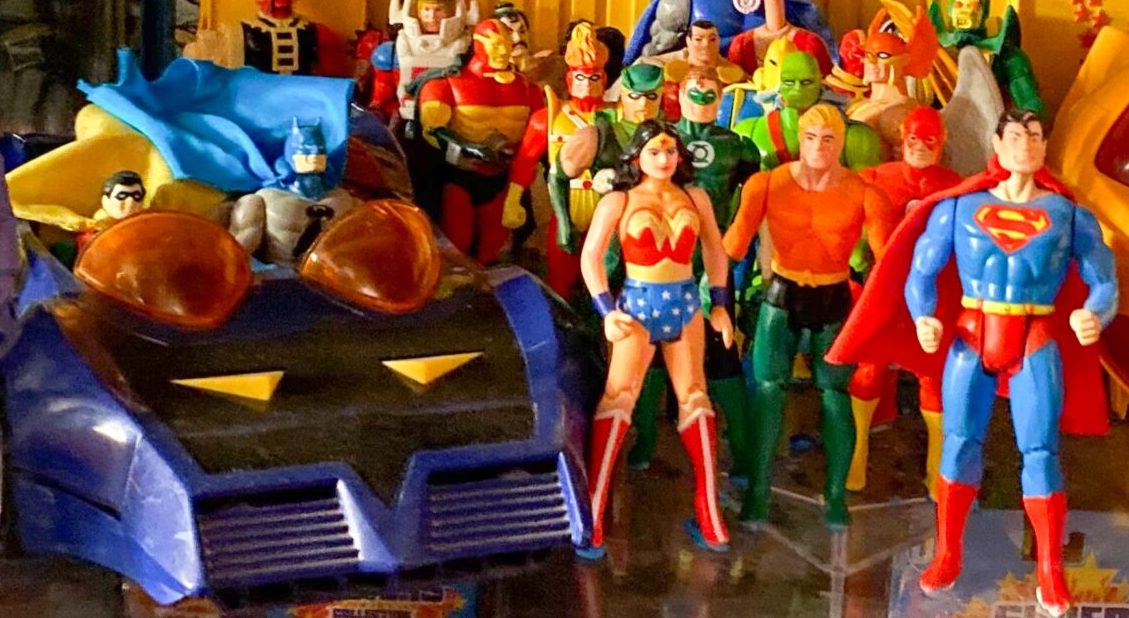
To celebrate the 4oth Anniversary of the Super Powers toy line and related media, the Fire and Water Podcast Network is releasing FW Presents Super Powers: The Legendary 40th Anniversary Show, a 3-part miniseries with a panel of guests and commentators covering their history with the toys, the cartoon, the comics and all things in between! Fire and Water Network All-Stars the Irredeemable Shag and (regular 13th Dimension contributor) Rob Kelly, are joined by Secret Wars and Beyond Podcast’s Sean Ross, Fanholes Podcast Network’s Derek William Crabbe, blogger Steve Givens, and Harvey Award-winning author David Gallaher. They have answered the JLA signal device call of host and producer Chris Franklin to discuss what they love about this era of DC Comics media! Be sure to check out the 3-part series currently running at fireandwaterpodcast.com, and on your favorite podcatcher under the FW Presents feed!
What follows is Chris’ personal experience with the Super Powers brand, from when he first discovered it as a child in 1984, through his time as an adult collector today.
—
By CHRIS FRANKLIN
Forty years ago, I came upon an ad on the back cover of one of my newly purchased DC comics. I can’t tell you which comic, because this ad was ubiquitous, showing up thereafter on every DC comic I bought in 1984 and perhaps beyond. But it made perfect sense, because this ad featured DC characters, and announced a brand-new toy line I was previously unaware of: Kenner’s Super Powers Collection.
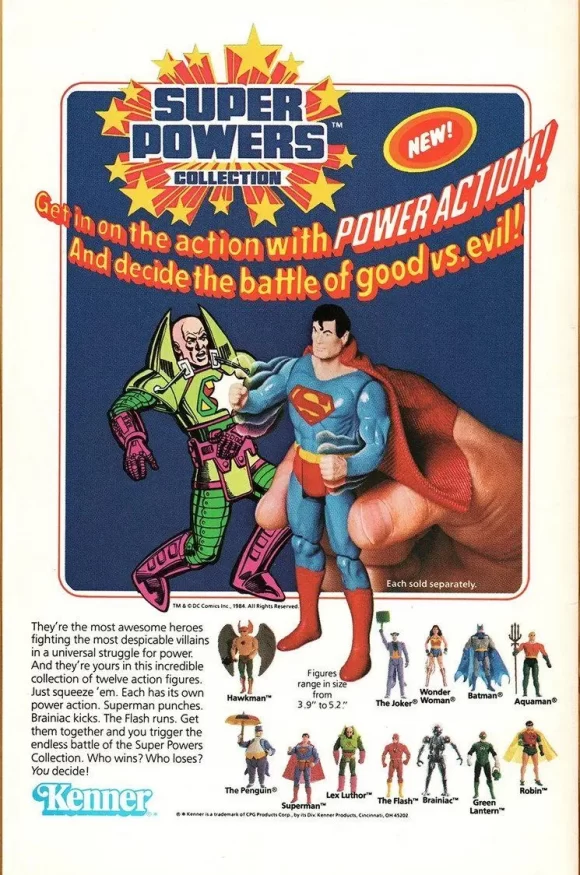
Ubiquitous back cover comic ad announcing the Super Powers Collection
I (and the world) had been bereft of superhero action figures for two years, ever since Mego dropped their long-running World’s Greatest Super-Heroes toy line on their way to bankruptcy. This ad promised everything I had ever dreamed of in a toy line: The central image depicted a child’s hand squeezing the legs of a new Superman figure, with motion lines showing that this activated his “Power Action” to punch the comic drawing of the newly redesigned, war-suited Lex Luthor.
Superman had a cloth cape, but otherwise was cast entirely in plastic, unlike the Mego figures. Likewise, the fidelity to the comic design was unparalleled. Even more exciting, below him the entire 12-figure assortment was revealed in tiny thumbnail images. I had Mego figures of Superman, Batman, and Robin in various formats, a 12-inch Wonder Woman, and a Pocket Super Heroes Lex Luthor, but no other DC heroes or villains. Here was practically the entire Justice League laid out before me! My beloved Dynamic Duo, of course, but also Wonder Woman, Aquaman, Flash, Green Lantern and Hawkman, the last three of which I knew Mego never even made!
And the villains! Not only did we get Lex, but the recently redesigned, and much scarier Brainiac, and Batman’s most popular rogues the Joker and the Penguin! And, like Superman, they all looked like they had just stepped right off the comic page. Green Lantern had his Power Battery! Aquaman had a trident! Joker had… wait? What DID Joker have? (It was a Joker-faced mallet, but I couldn’t really tell at this size). Needless to say, I was beyond excited to see these in person, and buy every single one!
Super Powers TV commercial compilation, from Henderson Productions 2
Then the TV ads began to appear, with a breathless narrator telling us of the heroes were coming from the farthest reaches of the universe to challenge the worst villains on Earth. The opening animation looked like it came straight from the new DC artwork I had seen on a few other pieces of recent DC merchandise. I immediately identified it as the work of one of my favorite (but infrequent) comic artists, Jose Luis Garcia-Lopez (Praised Be His Name)!
Like many toy commercials of the time, there was always a segment with children playing with the figures, showcasing the “Power Action Features” in a role-playing scenario where we, the kids, would determine the fate of the most noble of heroes and vilest villains. This was not unlike the popular “Choose Your Own Adventure” series of children’s books released around this time. The closing tag line said it all: “YOU DECIDE!!!”
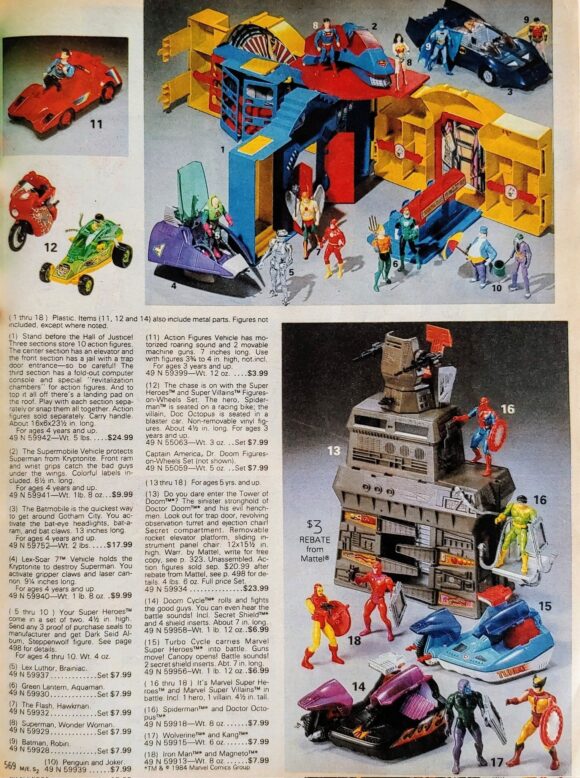
1984 Sears Wish Book catalogue page, from Battle Armor Dad X
That was a lot of responsibility for a 9-year old, but I was ready. The annual arrival of the Sears Wish Book catalogue in late summer/early fall was always a big event for kids for decades, but this year, the anticipation was palpable! I remember racing home to see if it came in for weeks, but to no avail. Then one magical day, it arrived. And there on a page that also displayed Mattel’s offering of the concurrent Marvel Super Heroes Secret Wars figures was the entire first wave of the Super Powers line, including two items that were soon at the top of my birthday/Christmas list: the Batmobile and the Hall of Justice.
I didn’t have to wait long for one of those, as a random weekday was eternally burned into my brain when my Mom told me to go look on my bed when I came in from school. I walked in, and there sat the colorful, beautifully illustrated box of the Batmobile, and carded figures of Batman and Robin (with art by Garcia-Lopez)! I don’t know why to this day my Mom chose to give me such a gift for no discernable reason, but I’ve never complained about it! That Batmobile is for my money the best toy version of fiction’s greatest vehicle EVER MADE. The flip-up Bat-eye headlights, the rear villain catcher and the front-nose battering ram were icing on the cake for a mostly faithful interpretation of the late ’70s/’80s comic-book iteration of the Dynamic Duo’s ride.
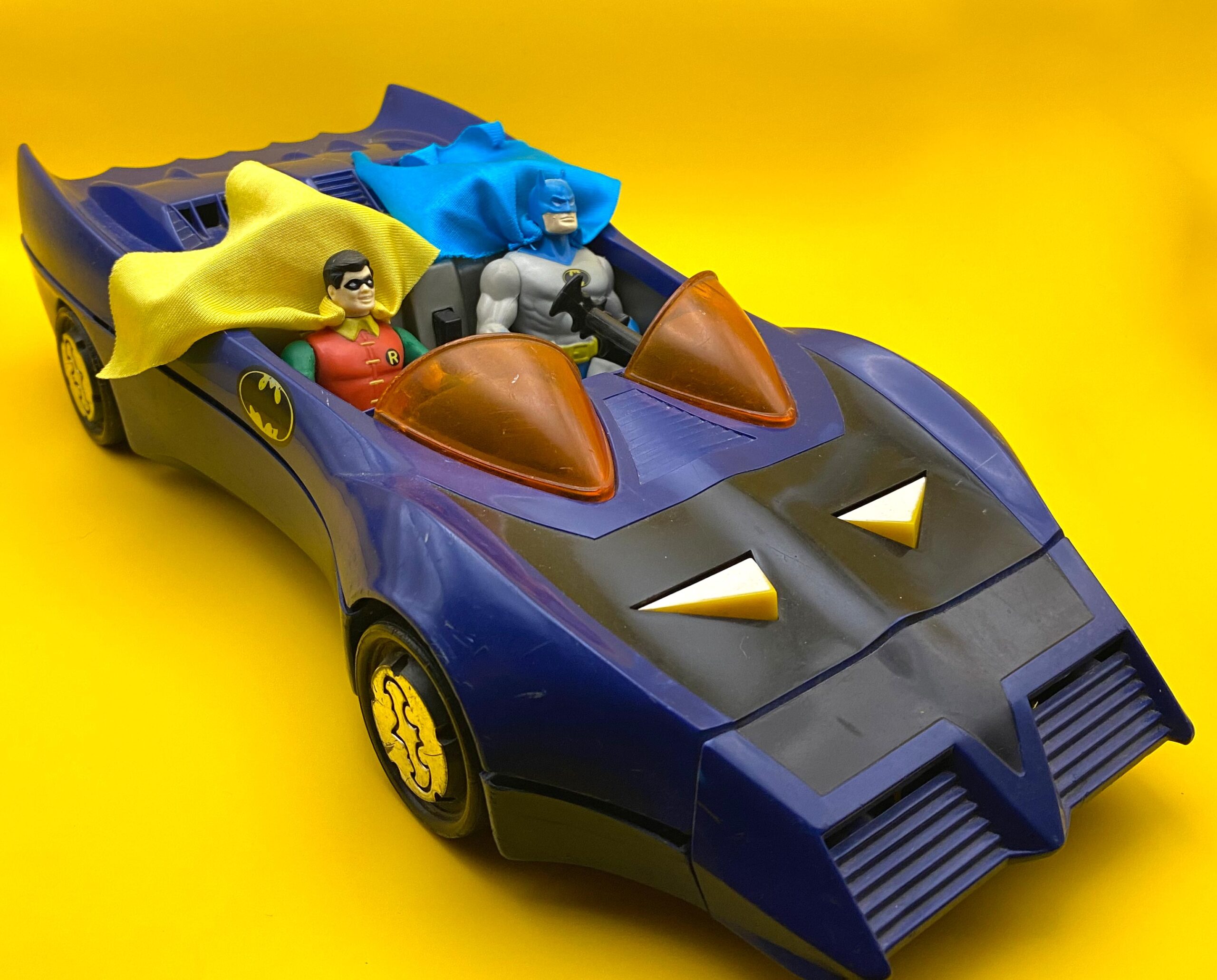
Chris’ childhood Batmobile
For my birthday in December of 1984, I received a Holy Grail I had wanted in toy form since before I can even remember. I had no idea Mego had made their own version of the Hall of Justice, but how could it compete with this one? This looked JUST LIKE the version from the Super Friends cartoon, except cast in yellow plastic. There was some precedent for this in the tie-in Super Friends comic, but it still seemed a bit odd. No matter — the jail, the elevator, the landing pad, and most importantly the meeting table, really made this a wonderful environment to launch a thousand adventures. I vividly remember putting this playset together while my family watched the annual rerun of one of my favorite films, the 1951 version of A Christmas Carol, starring Alastair Sim.
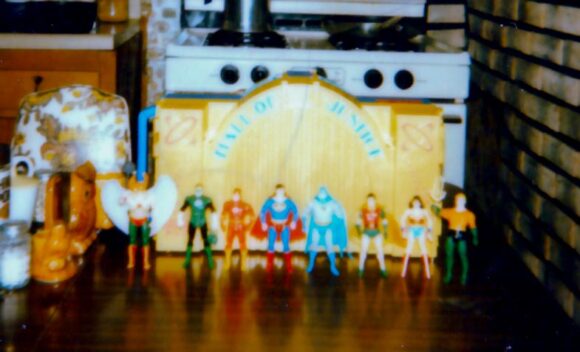
Photo taken in Chris’ childhood kitchen
By the time that Christmas came and went, I had every figure and vehicle in that first wave (including the Supermobile and Lex-Soar 7 flying ships). I even took a picture of all the heroes lined up in front of their glorious headquarters for posterity’s sake. Even as a child, I could appreciate the craftsmanship Kenner put into this line, clearly working closely with DC to get all the details just right. The Power Action features were fun (particularly Hawkman’s flapping wings), but the selling point of the line for me was the breadth of characters and the quality of the sculpting. The beautifully rendered packaging by Garcia-Lopez and other DC artists was icing on the cake. Another bonus was the included mini comics obviously created by actual writers and artists working for DC. They were uncredited, but even then, I recognized some of the art of Eduardo Barreto, Paris Cullins, Alex Saviuk and Greg Theakston (for more on the Super Powers mini comics, check out my earlier piece, 13 THINGS TO LOVE ABOUT THE 1984 KENNER SUPER POWERS MINI-COMICS — RANKED).
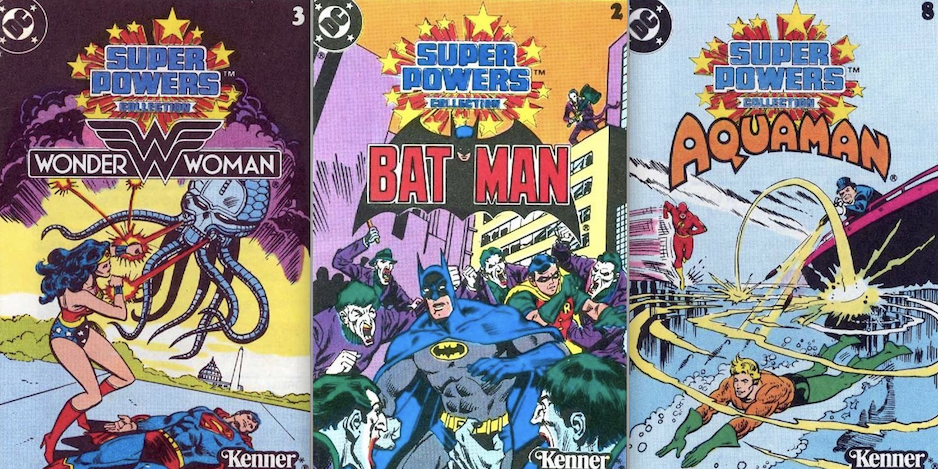
Also in 1984, the Super Friends had returned to ABC Saturday mornings in a refreshed format named Super Friends: The Legendary Super Powers Show. Change was in the air, with the addition of one of DC’s newer heroes, Firestorm, to the team, and no less than Batman himself, Adam West replacing Olan Soule as the voice of the Caped Crusader. (Soule was still on the show as part of Firestorm’s dual alter ego, Professor Martin Stein.) Things had taken a far more action-oriented, serious turn, with the addition of Darkseid and his minions as the primary antagonists. Jack Kirby’s intergalactic despot made a great foil for the super heroes, and the direction of the toy line was now set with the heroes protecting Earth from a complete invasion from Apokolips.
This of course built anticipation for the second wave of figures, which included Firestorm and Darkseid, Desaad and Kalibak as seen on the TV series. Fellow Fourth World baddies Mantis, the Parademon and Steppenwolf (originally offered as a mail-in) followed, but even more exciting were the new heroes: JLA founding member Martian Manhunter, Red Tornado and two of my personal favorites, Green Arrow and Dr. Fate. Dr. Fate! From Earth-Two!?! How deep were they going to go? Was I going to get a Jay Garrick Flash or an Alan Scott Green Lantern? My mind boggled!
I seem to remember getting a jump on this second wave quicker than the first, buying most of them myself with money from good report cards and lawn mowing work. For Christmas that year I received the massive Darkseid Destroyer Vehicle and the very Kirby-like Kalibak’s Boulder Bomber. I somehow missed out on the Delta Probe One vehicle designed for general heroic use.
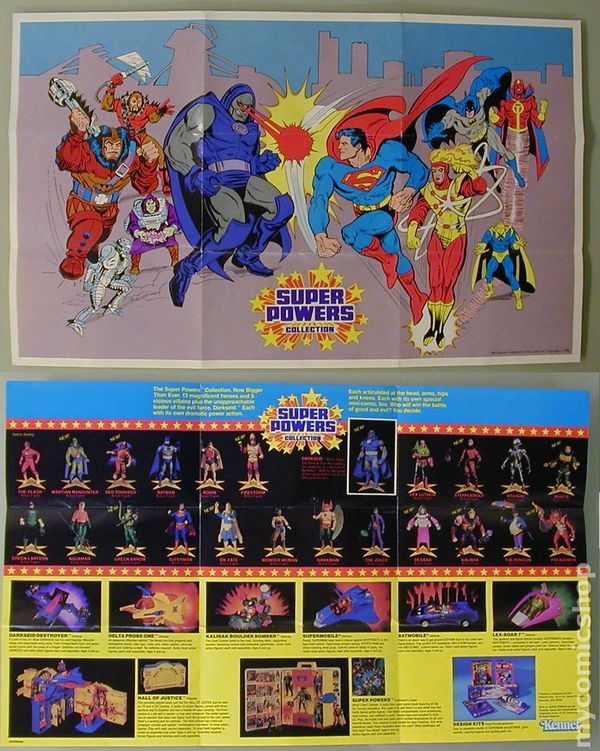
Insert catalog/poster featuring the second series, courtesy of mycomicshop.com
The fall of 1985 brought another season of the Super Friends… but things had REALLY changed this time! In fact, the show and the team were no longer called “Super Friends” at all. Super Powers Team: Galactic Guardians was a bit of an unwieldy title, but I wasn’t complaining! Although I loved the eternal Alex Toth model sheets used for the previous eight seasons, the show had a new look that just seemed right. The characters were now based directly on those Garcia-Lopez DC Comics Style Guide drawings!
Cyborg of the New Teen Titans (voiced by Ghostbusters’ Ernie Hudson) joined the team, adding much needed diversity in a far more subtle way than the previous created for TV “ethnic” super heroes like Black Vulcan, Samurai, Apache Chief and El Dorado (although I still have a soft spot for those characters). Even more impressive were the stories, with two that once seemed impossible to ever make it to Saturday morning. “The Death of Superman” dealt with just that, the apparent demise of the Man of Steel, inspired by Jerry Siegel’s classic imaginary comic tale from the 1960s, but also pointing toward the more famous comic event of 1992. The second one was the one that hit closest to home for this Batman fan: “The Fear.”
Thanks to the machinations of the Scarecrow, the Caped Crusader is confronted with the long-repressed trauma of his parents’ murder. This was the first time Batman’s origin was shown ANYWHERE outside of the comics! This episode, and much of the last two seasons were largely the work of writer and story editor Alan Burnett, who would go on to great acclaim as one of the primary architects of Batman: The Animated Series. Future BTAS and DC Animated Universe creative staff, including writer Rich Fogel, storyboard artist Frank Paur, voice director Andrea Romano and executive Jean MacCurdy were also involved in these final Super Friends/Super Powers episodes, bridging the gap to the more sophisticated themes of those later Warner Bros. Animation series.
But the cartoon wasn’t the only way to get regular Super Powers adventures. DC published three separate miniseries from 1984 to 1986, showcasing each wave of new figures. Series 1 was primarily written by Joey Cavalieri and drawn by Adrian Gonzales, depicting our heroes battling their rogues, and a series of new acolytes unleashed on the world by Darkseid. Jack Kirby provided the covers, the overall plot, and the story and art of the last issue, #5.
Kirby returned as penciller and cover artist (with Greg Theakston on inks) for the second mini in 1985, with the story now coming from “The Celebrated Mr. K” himself, Paul Kupperberg. This was my favorite of the batch, pitting the expanded heroes (including those from Wave 2) against all of Darkseid’s minions and his plan to unleash his “Seeds of Doom” throughout Earth’s past, present and future. This plot was also roughly adapted into the premiere episode of Super Powers Team: Galactic Guardians.
Kupperberg channeled the classic split-team format of Gardner Fox’s Silver Age Justice League of America comics to great effect. Seeing the DC pantheon drawn by the primary artistic architect of the Marvel Universe was quite a treat, and this is where I really learned to love and appreciate Kirby’s somewhat iconoclastic late art style. In some ways the antithesis of the iconic JLGL Style Guide art, they both scream “SUPER POWERS” to me to this day.
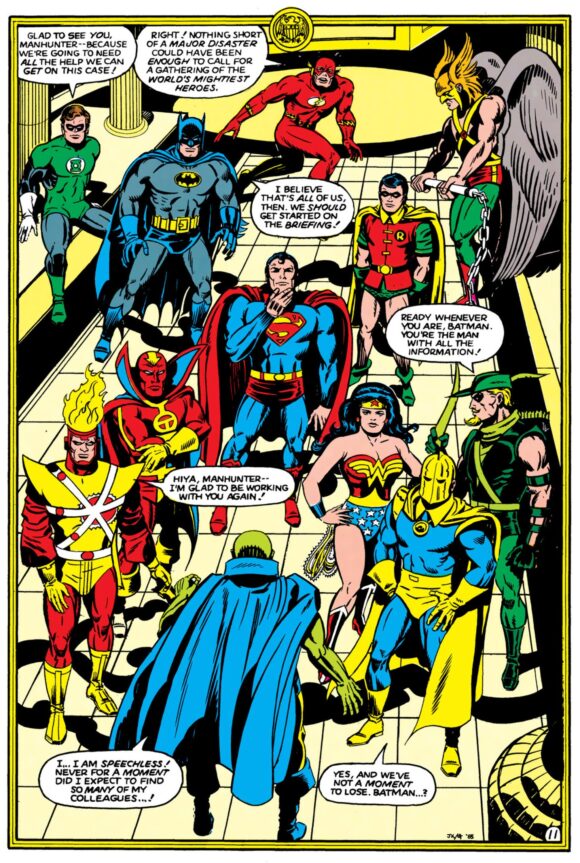
Splash page from Super Powers (Vol 2) #1, written by Paul Kupperberg, pencils by Jack Kirby, inks by Greg Theakston
Kupperberg returned for the third series, but the art chores went to someone who was no stranger to DC — primary Silver Age artist and Bronze Age publisher Carmine Infantino. The story introduced the Wave 3 characters and gave us an origin for long-time Super Friend Samurai as well as the created-for-the-toy-line Golden Pharoah and Cyclotron. Legendary heroes Captain (Shazam!) Marvel and Plastic Man joined Kirby’s Mister Miracle and Orion, who had a makeover that blatantly ripped off the Masters of the Universe character Man-E-Faces.
Batman rogue Mr. Freeze (also redesigned for the toy line) and a strangely time displaced and VERY obscure Legion of Super Heroes villain Tyr rounded out the wave. I was flummoxed by some of these choices, particularly the “made-up” Golden Pharoah and Cyclotron. Didn’t DC have enough great characters to fill up several more waves before the toymaker started creating new ones? Where were the other Titans, more JSA members? Heck, where were Batgirl, Supergirl, the Riddler, Bizarro? And where were the mini comics, dropped for this third wave?
I bought the figures I could find, but I was growing frustrated with the line in some ways. Turns out I didn’t have to stay frustrated for too long, as the line just vanished from shelves after 1986. I passed up my one chance to own the now insanely rare and expensive Cyborg, buying Captain Marvel instead. As a child, I never got the Batcopter, and never saw the lame Justice Jogger contraption that has become a running gag among collectors. Even more depressing, the massive Darkseid Tower of Darkness advertised on the last series cardbacks never made it into production at all. The cartoon was gone with no third season, ending the Super Friends’ decade-plus run. The last comic-book miniseries ended on a still-unresolved cliffhanger, with Orion walking off with new hero Janus, actually his evil father Darkseid in disguise!

The final page of Super Powers (Vol. 3) #4 ends on a cliffhanger! Written by Paul Kupperberg, with pencils by Carmine Infantino and inks by Pablo Marcos.
My last great joyful Super Powers memory was the much-anticipated arrival of my mail-away Clark Kent action figure. The offer was cleverly advertised in a TV spot featuring Marc McClure reprising his Jimmy Olsen role from the Christopher Reeve Superman and Supergirl films. Clark took the full 14 weeks to arrive, and I checked my mailbox (somewhat) patiently every day, much like Ralphie Parker in A Christmas Story, waiting on his Little Orphan Annie decoder pin. Unlike Ralphie, I was not disappointed by the figure of the mild-mannered reporter. I seem to recall that Clark came in just as I was finding those last-wave three figures. He was in many ways the last gasp of glory for the Super Powers line for me.
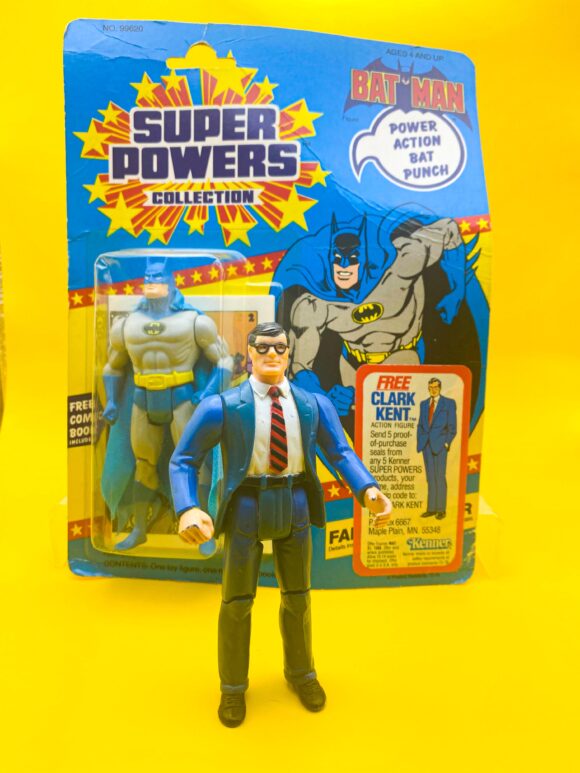
Clark Kent mail-away figure, with a carded Batman featuring the offer sticker
With no internet and no magazines available to let me know of the line’s demise, at some point I realized there would be no Series 4. I limped along in my last toy-playing days, refocusing on G.I. Joe: A Real American Hero, Transformers, and M.A.S.K. (another great Kenner line). Nearly as soon as I put my toys away for play, I decided to become a toy collector, just like the people I had been reading about in magazines I had recently discovered like Toy & Model Collector, Comic Buyers Guide and Toy Shop. But I picked the worst time in the late 20th century to do so, as there were NO superhero toys on the shelves from 1987 through 1988.
All of that would soon change with the arrival of the phenomenon known as the 1989 Tim Burton-directed Batman film starring Michael Keaton. Fledgling company Toy Biz would bring back or modify some of the Kenner molds in both their Batman and sister DC Comics Super Heroes line, but the quality had taken quite a dip. Kenner would get the license back in 1990 and reconfigure some of their molds for further use in their Batman: The Dark Knight Collection and Batman Returns lines.
Seeing the carry-through from my beloved Super Powers line was always a treat, but I longed for Kenner to just restart the line. Alas, they never did. Thematically, they came closest with the ’90s Total Justice series, but by then the beautifully subtle aesthetics of the Super Powers line had been replaced by extreme roid rage.
I wasn’t alone in wanting to relive the glory of the Super Powers era. Mattel’s DC Universe Classics series of the 2010s recreated every Super Powers character in 6” format, beautifully sculpted by the Four Horsemen Studios. Gentle Giant released up-sized, 12-inch collector figures based directly on the molds. And of course, McFarlane Toys revived the line just a few short years ago, in the same scale, and with very similar packaging.
After a bit of a bumpy start, they managed to capture the feel of those original Kenner figures, giving us reinterpretations of the classic characters, as well as additions we would have loved to have seen in the ’80s, such as Blue Beetle, Booster Gold and Deathstroke. Their vehicles are perhaps even more impressive, giving us Blue Beetle’s Bug, Wonder Woman’s Invisible Jet, a Whirly-Bat, and a Supermobile that is far more comic-accurate than even Kenner’s Super Powers version!
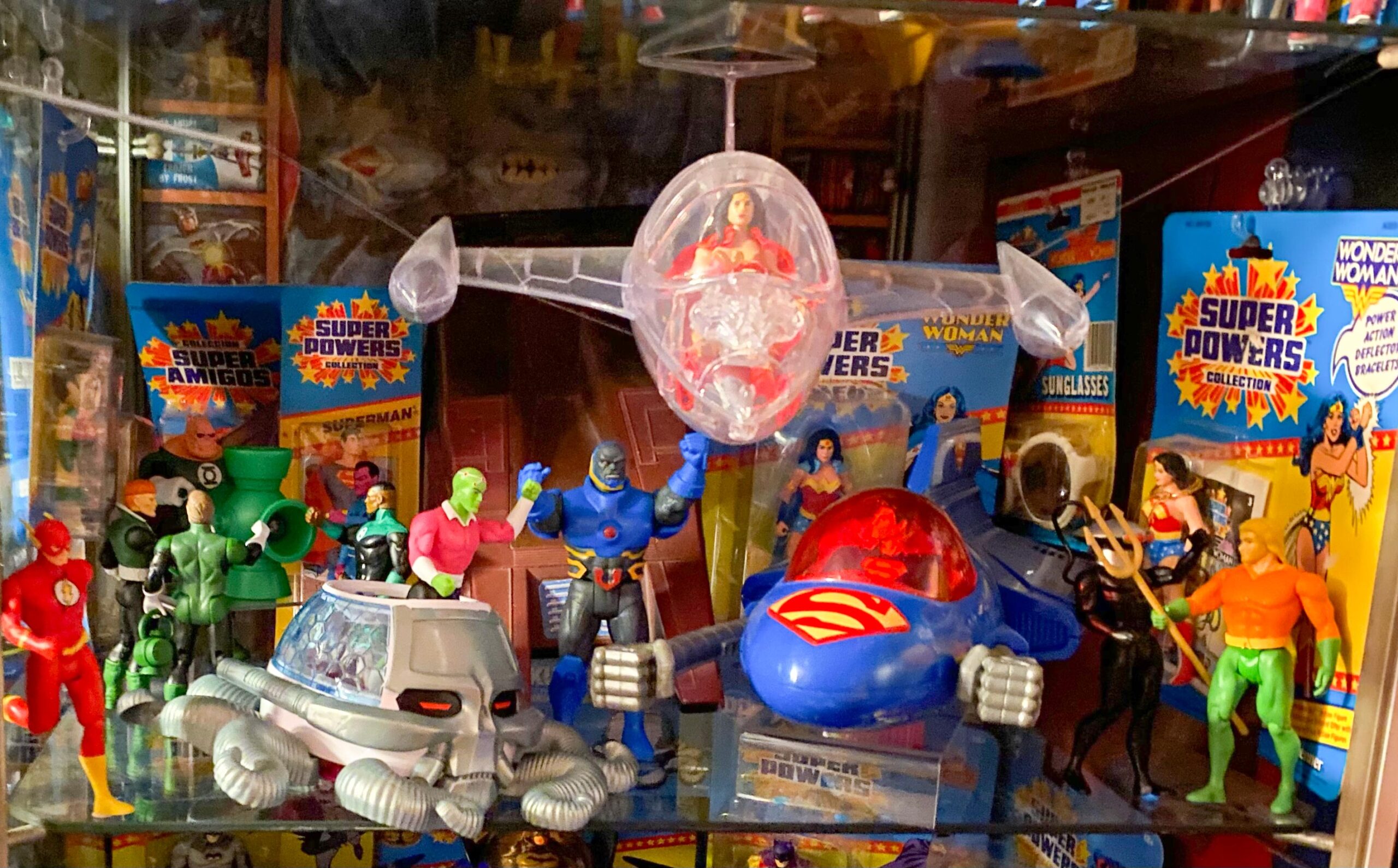
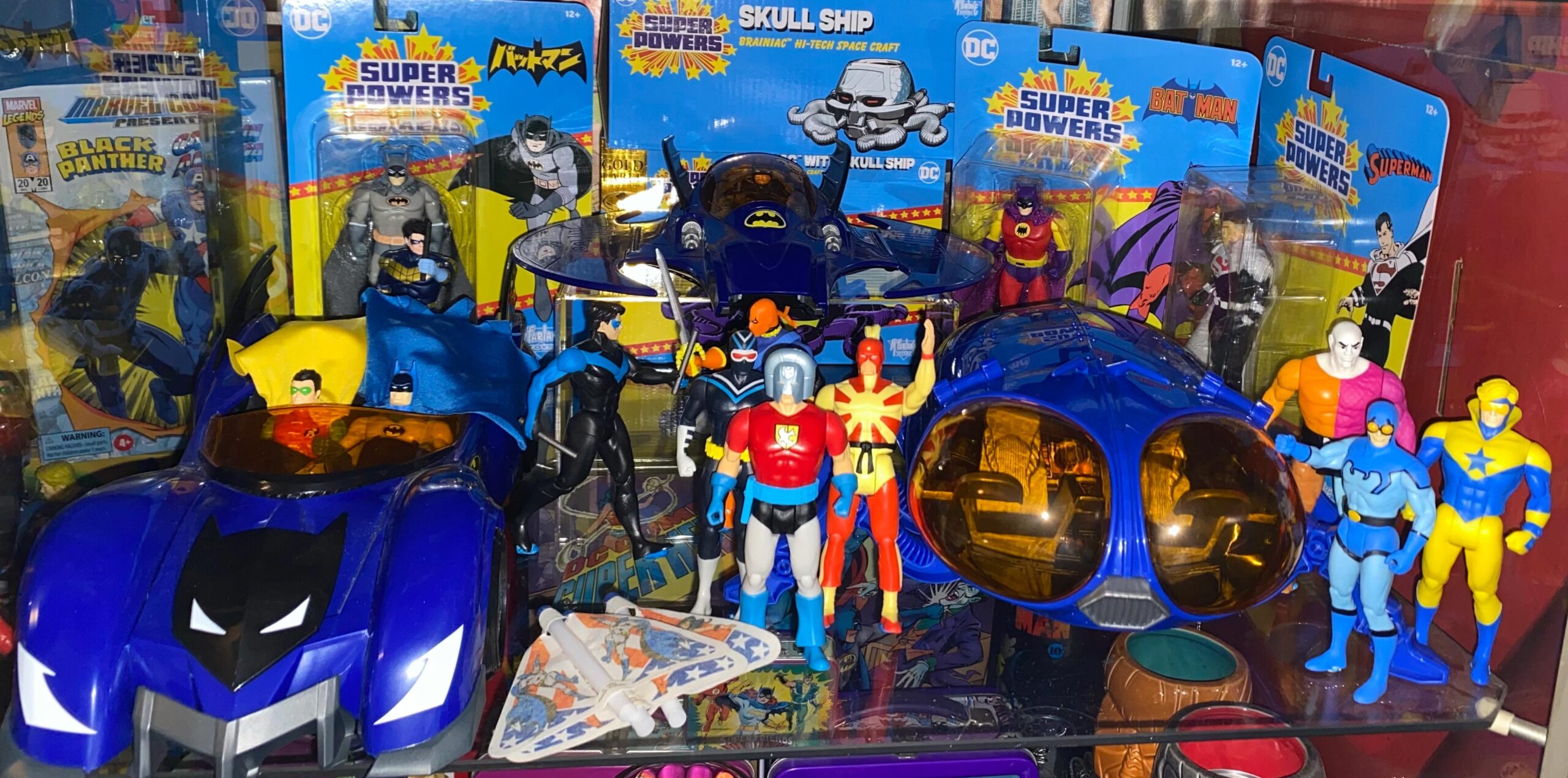
Chris’ collection of current McFarlane Toys Super Powers figures and vehicles
Every kid has their Golden Age, and the era of Kenner’s Super Powers toys was mine. I was old enough by then to really understand the characters, their stories, and how the mythology worked. I could use the toys to expand those stories, and even predict a few things to come, such as my own death of Superman, and Lex Luthor as president! Looking back now, I also see it and the related media as the last gasp of DC’s Bronze Age, before the Crisis on Infinite Earths reboot and more adult-oriented material like Frank Miller’s The Dark Knight would forever change how we look at the DC heroes. As an adult collector, I have happily filled in most of the holes in my collection (Cyborg aside), but many of the items I have are still my childhood copies, well-loved and played with.
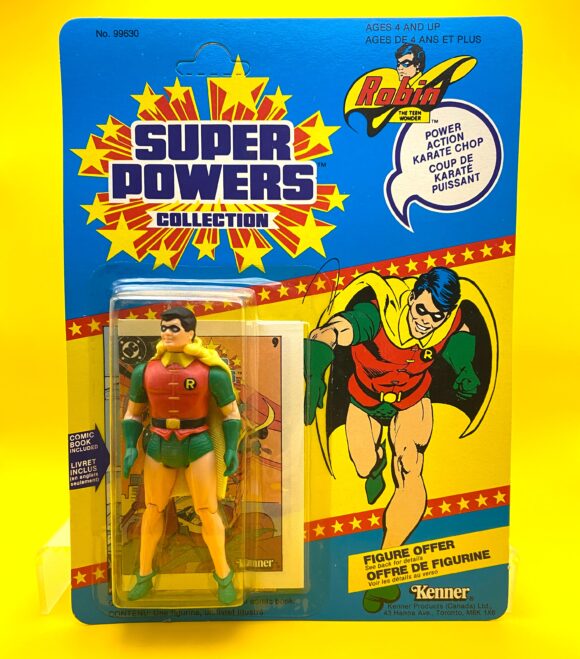
Robin on carded bilingual card from Chris’ collection
Sheer nostalgia aside, the attention to detail, the level of sculpting, and the overall cohesive nature of the Kenner line is what makes it stand out as one of the best action figure lines of all time, even to this day. Despite my love for Mego’s output, to my notion, it’s the greatest superhero toy line ever created.
Do you agree? Is there another that you believe is better, or means more to you? Well, that’s up to you. YOU DECIDE!!!
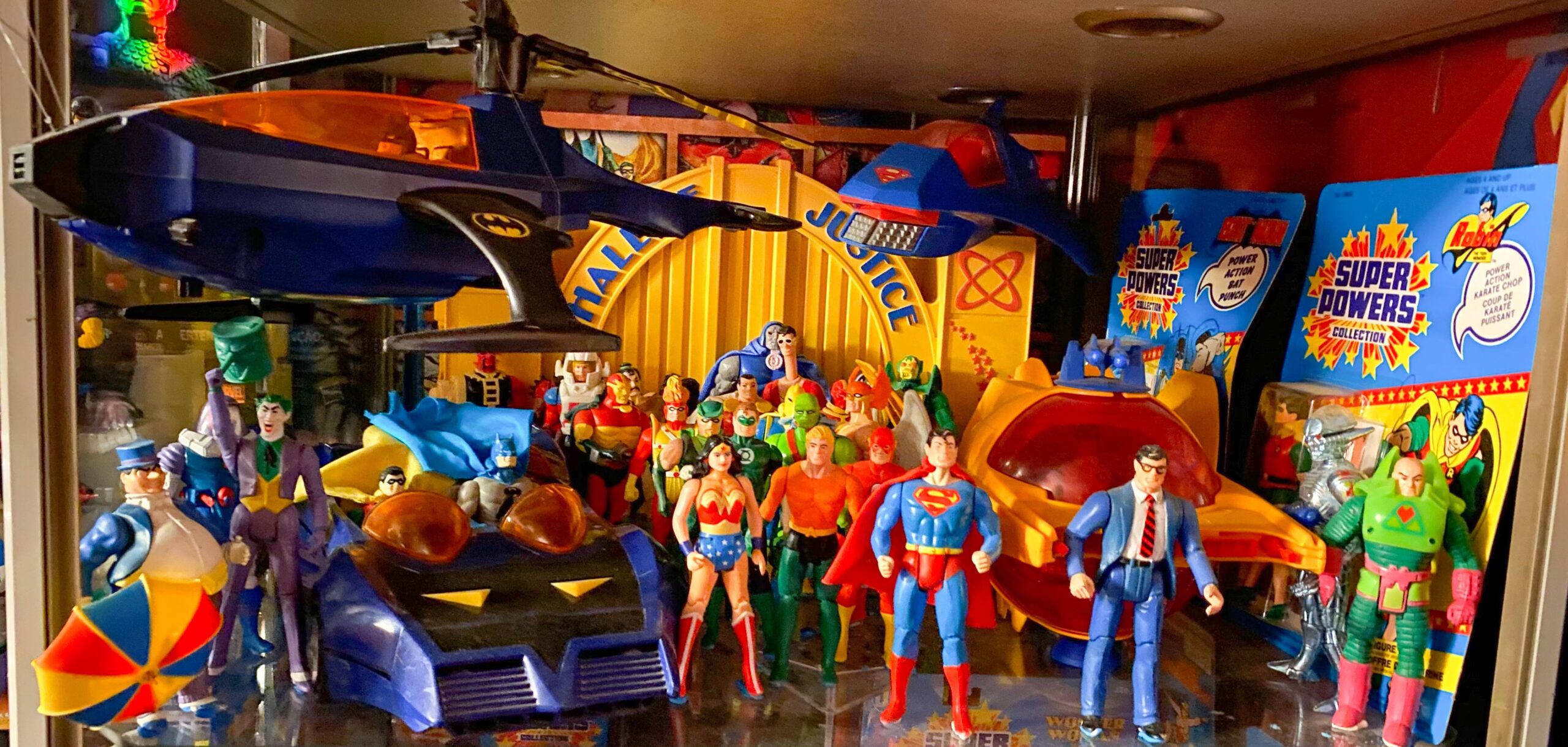
Part of Chris’ vintage Super Powers collection
—
MORE
— DC’s SUPER POWERS VARIANT COVERS: A Goldmine Just Waiting There for McFARLANE TOYS. Click here.
— 13 THINGS to Love About the 1984 KENNER SUPER POWERS MINI-COMICS — RANKED. Click here.
—
13th Dimension contributor Chris Franklin is a graphic designer, illustrator, writer, and podcaster, who co-hosts and produces several shows on the Fire and Water Podcast Network, including JLUCast.

August 11, 2024
Wishing “Super Powers” a happy 40th anniversary!
August 11, 2024
Mego toys were the favorites of my generation (before Kenners’ Star Wars toys took over), but I have to admit to thinking my little brother’s Super Powers toys were pretty cool.